I have two map plots of 'Total Population' and 'Population Density' created using a shape file. Now, I'm trying to build a shiny app so that I can change from Total Population to Population Density and the plot should change accordingly. When I ran the code, i got following error code:
Warning: Error in : ggplot2 doesn't know how to deal with data of class matrix
Here's the code that i've been trying to use:
library(shiny)
library(ggplot2) #Loading necessary libraries
ui <- fluidPage(
selectInput("mr",
label="Type of Plot",
choices=c("Total Population", "Density"),
selected="Total Population"),
plotOutput("curv") #Giving an input name and listing out types to choose in the Shiny app
)
server <- function(input, output){
output$curv <- renderPlot({
ggplot() +
geom_polygon(data = final.plot==input$mr,
aes(x = long, y = lat, group = group, fill = Population),
color = "black", size = 0.20) +
coord_map()+
scale_fill_distiller(name="Population", palette = "YlGn")+
labs(title="Population in Australia")
}) # Output with the data file and input string to change when input changes.
}
shinyApp(ui = ui, server = server)
Any help is greatly appreciated.
UPDATE:
My dataset looks like this:
id long lat order hole piece
1 Ashmore and Cartier Islands 123.1169 -12.25333 1 FALSE 1
2 Ashmore and Cartier Islands 123.1206 -12.25611 2 FALSE 1
3 Ashmore and Cartier Islands 123.1222 -12.25861 3 FALSE 1
4 Ashmore and Cartier Islands 123.1239 -12.25528 4 FALSE 1
5 Ashmore and Cartier Islands 123.1258 -12.25333 5 FALSE 1
6 Ashmore and Cartier Islands 123.1275 -12.25619 6 FALSE 1
group Population Density
1 Ashmore and Cartier Islands.1 NA NA
2 Ashmore and Cartier Islands.1 NA NA
3 Ashmore and Cartier Islands.1 NA NA
4 Ashmore and Cartier Islands.1 NA NA
5 Ashmore and Cartier Islands.1 NA NA
6 Ashmore and Cartier Islands.1 NA NA
This is stored in the DataFrame called "final.plot". There's values of Population and Density for other states. I was able to create a static visualisation of Population and it looks like this:
There's a similar one for Density and I'm trying to create Shiny app where i can switch between these two so that the plot changes accordingly. Right now I've tried the following code:
library(shiny)
library(ggplot2) #Loading necessary libraries
ui <- fluidPage(
selectInput("pop",
label="Type of Plot",
choices=c("Population", "Density"),
selected="Total Population"),
plotOutput("curv") #Giving an input name and listing out types to choose in the Shiny app
)
server <- function(input, output){
output$curv <- renderPlot({
ggplot() +
geom_polygon(data = final.plot,
aes(x = long, y = lat, group = group, fill = input$pop),
color = "black", size = 0.25) +
coord_map()+
scale_fill_distiller(name="Density", palette = "Spectral")+
labs(title="Population in Australia")
})
}
shinyApp(ui = ui, server = server)
But I'm getting an error saying "Discrete value supplied to continuous scale".
UPDATE 2: Here's the link for the dataset i'm using: Dataset

